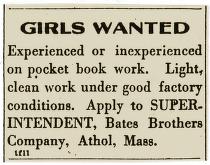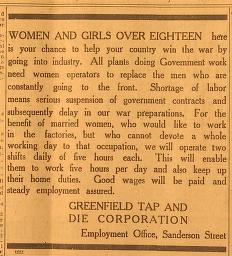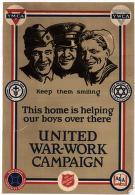|

WWI letter to Emily Gladys Bartlett

"More Power to the Allies"

"Allies, Arise!"

"Girls Wanted" advertisement

"Experienced Girls Wanted" advertisement

"Women and Girls Over 18" employment ad in Greenfield's Gazette and Courier newspaper

"Farmers Help the Belgians"

"Keep them smiling"- WWI broadside
|
Summary and Objective
Students will study advertisements, posters, and/or letters from the World War I time period. They will understand that the advertisements and/or letters provide a picture into the culture of the time period. Based on their research and classroom discussions the students will answer questions such as:
What do the advertisements and/or posters tell us or show us about this time period?
What do the letters tell us or show us about this time period?
Do the advertisements, posters and/or letters provide indications about events that may happen as we continue our studies?
Do the advertisements, posters and/or letters allow us to understand the role of various segments of the society?
Teaching Plan
Step 1.
A short discussion about how advertisements and letters reflect the culture of the times.
Step 2.
One to two periods in the computer lab for students to access material at the American Centuries website as well as additional links (as necessary). Review with students the correct way to cite Internet resources (see below) and the correct way to save an image (see below). Students will use the Internet resources to explore the following questions:
What do the advertisements tell us or show us about this time period?
What do the letters tell us or show us about this time period?
Do the advertisements and/or letters provide indications about events that may happen as we continue our studies?
Do the advertisements and/or letters allow us to understand the role of various segments of the society?
Are all the advertisements a reflection of the impact of the war, or are some of the advertisements a reflection of cultural events/activities?
Optional:
As a class activity look at an advertisement and/or a letter with the class and discuss what we can learn from this artifact. Ask the question What does this artifact tell us or show us about this time period? Based on our current knowledge and looking to the past, does the artifact provide any clues about what may happen in the future? Does the artifact allow us to gain a better understanding of the role of individuals within the society?
Citing an Internet resource:
Authors name with last name first (if known); the full title of the work in quotation marks; the title of the complete work (if applicable) with as much detail as possible (version, file numbers, etc.); the date posted or of last revision (if available); the full URL (uniform resource locator this page must bring you to the work being cited!);the date of access in parentheses.
Saving an Image:
The directions are for saving on a PC (not an Apple computer).
Right click on the image (use the right mouse button). This will bring up a menu.
Select Save Image As command.
A dialogue box will open that saves Save Image in the upper left hand corner. At this point you have the option of choosing the location where the picture will be saved. If students have a folder suggest they save the picture in their folder. In the same dialogue box the student will have the option of changing the name of the picture (bottom of the dialogue box line called File Name). Suggest to students that they save the file with a name that they will recognize at a later point.
Step 3.
Students will write a short paper addressing the issue of how the primary documents they studied reflected the culture of the time. As an alternate assignment student may create a PowerPoint slide show with an oral presentation, or design their own advertisement using information learned from the research with a written explanation.
Step 4.
EXTENSION:
Students may return to this project when World War II is studied and compare and contrast how each war was viewed through the eyes of the media, addressing issues of how the concept of each war is reflected by the media and how the concept of war may or may not have changed.
|




